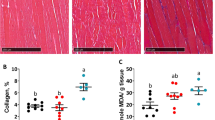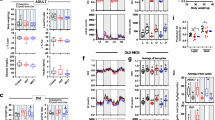Abstract
In skeletal muscles, calorie restriction (CR) preserves muscle mass in middle-aged rats but not younger rats. The underlying mechanisms for this age-specific response are unknown. Skeletal muscle mass depends on several factors, with protein synthesis and degradation playing major roles. Therefore, the purpose of this study was to investigate whether CR affects younger and older animals differently on mTOR signaling and ubiquitin-proteasome pathway (UPP). Four-, 8-, and 16-month-old rats, with or without 40% CR for a duration of 14 weeks, were sacrificed after an overnight fasting. Total protein content and the phosphorylation level of AKT, mTOR, S6K, and 4EBP1 and protein content of key markers in the UPP (FOXO3a, atrogin, MuRF1, ubiquitinated proteins, proteasome subunits alpha 7 and beta 5) were determined. Unlike younger rats, CR decreased the content of phosphorylated mTOR, S6K, phosphorylated S6K, FOXO3a, and ubiquitinated proteins in middle-aged rats. In conclusion, CR-induced reduction of content/ phosphorylation levels of key proteins in mTOR signaling and the UPP occurred in the middle-aged rats but not younger rats. The age-dependent effects of CR on mTOR signaling and the UPP indirectly explained the age-related effects of CR on muscle mass of animals.





Similar content being viewed by others

References
An JY et al (2017) Rapamycin treatment attenuates age-associated periodontitis in mice. GeroScience 39:457–463
Baar EL, Carbajal KA, Ong IM, Lamming DW (2016) Sex- and tissue-specific changes in mTOR signaling with age in C57BL/6 J mice. Aging Cell 15:155–166
Bonaldo P, Sandri M (2013) Cellular and molecular mechanisms of muscle atrophy. Dis Model Mech 6:25–39
Budenholzer L, Cheng CL, Li Y, Hochstrasser M (2017) Proteasome structure and assembly. J Mol Biol 429:3500–3524
Chen CN, Ferrington DA, Thompson LV (2008) Carbonic anhydrase III and four-and-a-half LIM protein 1 are preferentially oxidized with muscle unloading. J Appl Physiol 105:1554–1561
Chen CN, Brown-Borg HM, Rakoczy SG, Ferrington DA, Thompson LV (2010) Aging impairs the expression of the catalytic subunit of glutamate cysteine ligase in soleus muscle under stress. J Gerontol A Biol Sci Med Sci 65:129–137
Chen CN, Lin SY, Liao YH, Li ZJ, Wong AM (2015) Late-onset caloric restriction alters skeletal muscle metabolism by modulating pyruvate metabolism. Am J Physiol Endocrinol Metab 308:E942–E949
Chen CN et al (2017) Diet-induced obesity accelerates blood lactate accumulation of rats in response to incremental exercise to maximum. Am J Phys Regul Integr Comp Phys 313:R601–R607
Chung HY et al (2011) Molecular inflammation as an underlying mechanism of the aging process and age-related diseases. J Dent Res 90:830–840
Clavel S, Coldefy AS, Kurkdjian E, Salles J, Margaritis I, Derijard B (2006) Atrophy-related ubiquitin ligases, atrogin-1 and MuRF1 are up-regulated in aged rat Tibialis Anterior muscle. Mech Ageing Dev 127:794–801
Colman RJ, Beasley TM, Allison DB, Weindruch R (2008) Attenuation of sarcopenia by dietary restriction in rhesus monkeys. J Gerontol A Biol Sci Med Sci 63:556–559
Combaret L, Dardevet D, Bechet D, Taillandier D, Mosoni L, Attaix D (2009) Skeletal muscle proteolysis in aging. Curr Opin Clin Nutr Metab Care 12:37–41
Contreras NA, Fontana L, Tosti V, Nikolich-Zugich J (2018) Calorie restriction induces reversible lymphopenia and lymphoid organ atrophy due to cell redistribution. GeroScience 40:279–291
Csipo T, Fulop GA, Lipecz A, Tarantini S, Kiss T, Balasubramanian P, Csiszar A, Ungvari Z, Yabluchanskiy A (2018) Short-term weight loss reverses obesity-induced microvascular endothelial dysfunction. GeroScience 40:337–346. https://doi.org/10.1007/s11357-018-0028-9
Dalle S, Rossmeislova L, Koppo K (2017) The role of inflammation in age-related sarcopenia. Front Physiol 8:1045
Fang Y et al (2017) Differential effects of early-life nutrient restriction in long-lived GHR-KO and normal mice. GeroScience 39:347–356
Fontana L, Partridge L, Longo VD (2010) Extending healthy life span--from yeast to humans. Science 328:321–326
Francaux M, Demeulder B, Naslain D, Fortin R, Lutz O, Caty G, Deldicque L (2016) Aging reduces the activation of the mTORC1 pathway after resistance exercise and protein intake in human skeletal muscle: potential role of REDD1 and impaired anabolic sensitivity. Nutrients 8
Fujita S, Glynn EL, Timmerman KL, Rasmussen BB, Volpi E (2009) Supraphysiological hyperinsulinaemia is necessary to stimulate skeletal muscle protein anabolism in older adults: evidence of a true age-related insulin resistance of muscle protein metabolism. Diabetologia 52:1889–1898
Guillet C et al (2004) Impaired anabolic response of muscle protein synthesis is associated with S6K1 dysregulation in elderly humans. FASEB J 18:1586–1587
Ibebunjo C et al (2013) Genomic and proteomic profiling reveals reduced mitochondrial function and disruption of the neuromuscular junction driving rat sarcopenia. Mol Cell Biol 33:194–212
Kaeberlein M et al (2005) Regulation of yeast replicative life span by TOR and Sch9 in response to nutrients. Science 310:1193–1196
Kalinkovich A, Livshits G (2017) Sarcopenic obesity or obese sarcopenia: a cross talk between age-associated adipose tissue and skeletal muscle inflammation as a main mechanism of the pathogenesis. Ageing Res Rev 35:200–221
Kimball SR, O'Malley JP, Anthony JC, Crozier SJ, Jefferson LS (2004) Assessment of biomarkers of protein anabolism in skeletal muscle during the life span of the rat: sarcopenia despite elevated protein synthesis. Am J Physiol Endocrinol Metab 287:E772–E780
Lecker SH, Goldberg AL, Mitch WE (2006) Protein degradation by the ubiquitin-proteasome pathway in normal and disease states. J Am Soc Nephrol 17:1807–1819
Lee MB et al (2017) A system to identify inhibitors of mTOR signaling using high-resolution growth analysis in Saccharomyces cerevisiae. GeroScience 39:419–428
Lopez-Lluch G, Navas P (2016) Calorie restriction as an intervention in ageing. J Physiol 594:2043–2060
Lu Y, Bradley JS, McCoski SR, Gonzalez JM, Ealy AD, Johnson SE (2017) Reduced skeletal muscle fiber size following caloric restriction is associated with calpain-mediated proteolysis and attenuation of IGF-1 signaling. Am J Phys Regul Integr Comp Phys 312:R806–R815
Ma XM, Blenis J (2009) Molecular mechanisms of mTOR-mediated translational control. Nat Rev Mol Cell Biol 10:307–318
Markofski MM et al (2015) Effect of age on basal muscle protein synthesis and mTORC1 signaling in a large cohort of young and older men and women. Exp Gerontol 65:1–7
Marzetti E, Calvani R, Cesari M, Buford TW, Lorenzi M, Behnke BJ, Leeuwenburgh C (2013) Mitochondrial dysfunction and sarcopenia of aging: from signaling pathways to clinical trials. Int J Biochem Cell Biol 45:2288–2301
Mattison JA et al (2017) Caloric restriction improves health and survival of rhesus monkeys. Nat Commun 8:14063
McKiernan SH et al (2012) Cellular adaptation contributes to calorie restriction-induced preservation of skeletal muscle in aged rhesus monkeys. Exp Gerontol 47:229–236
Mercken EM et al (2013) Calorie restriction in humans inhibits the PI3K/AKT pathway and induces a younger transcription profile. Aging Cell 12:645–651
Mercken EM et al (2017) Conserved and species-specific molecular denominators in mammalian skeletal muscle aging. NPJ Aging Mech Dis 3:8
Messaoudi I et al (2008) Optimal window of caloric restriction onset limits its beneficial impact on T-cell senescence in primates. Aging Cell 7:908–919
Mirzoev T, Tyganov S, Vilchinskaya N, Lomonosova Y, Shenkman B (2016) Key markers of mTORC1-dependent and mTORC1-independent signaling pathways regulating protein synthesis in rat soleus muscle during early stages of hindlimb unloading. Cell Physiol Biochem 39:1011–1020
Morais JA, Jacob KW, Chevalier S (2018) Effects of aging and insulin resistant states on protein anabolic responses in older adults. Exp Gerontol 108:262–268
Morton RW, Traylor DA, Weijs PJM, Phillips SM (2018) Defining anabolic resistance: implications for delivery of clinical care nutrition. Curr Opin Crit Care 24:124–130
Nacarelli T, Azar A, Altinok O, Orynbayeva Z, Sell C (2018) Rapamycin increases oxidative metabolism and enhances metabolic flexibility in human cardiac fibroblasts. GeroScience 40:243–256. https://doi.org/10.1007/s11357-018-0030-2
Niemann B, Silber RE, Rohrbach S (2008) Age-specific effects of short- and long-term caloric restriction on the expression of adiponectin and adiponectin receptors: influence of intensity of food restriction. Exp Gerontol 43:706–713
Peake J, Della Gatta P, Cameron-Smith D (2010) Aging and its effects on inflammation in skeletal muscle at rest and following exercise-induced muscle injury. Am J Phys Regul Integr Comp Phys 298:R1485–R1495
Sakuma K, Aoi W, Yamaguchi A (2017) Molecular mechanism of sarcopenia and cachexia: recent research advances. Pflugers Arch 469:573–591
Sanchez AM, Candau RB, Bernardi H (2014) FoxO transcription factors: their roles in the maintenance of skeletal muscle homeostasis. Cell Mol Life Sci 71:1657–1671
Sandri M (2008) Signaling in muscle atrophy and hypertrophy. Physiology 23:160–170
Schiaffino S, Dyar KA, Ciciliot S, Blaauw B, Sandri M (2013) Mechanisms regulating skeletal muscle growth and atrophy. FASEB J 280:4294–4314
Sharples AP, Hughes DC, Deane CS, Saini A, Selman C, Stewart CE (2015) Longevity and skeletal muscle mass: the role of IGF signalling, the sirtuins, dietary restriction and protein intake. Aging Cell 14:511–523
Shin S, Wolgamott L, Tcherkezian J, Vallabhapurapu S, Yu Y, Roux PP, Yoon SO (2014) Glycogen synthase kinase-3beta positively regulates protein synthesis and cell proliferation through the regulation of translation initiation factor 4E-binding protein 1. Oncogene 33:1690–1699
Testa G, Biasi F, Poli G, Chiarpotto E (2014) Calorie restriction and dietary restriction mimetics: a strategy for improving healthy aging and longevity. Curr Pharm Des 20:2950–2977
Tremblay F et al (2005) Overactivation of S6 kinase 1 as a cause of human insulin resistance during increased amino acid availability. Diabetes 54:2674–2684
Um SH et al (2004) Absence of S6K1 protects against age- and diet-induced obesity while enhancing insulin sensitivity. Nature 431:200–205
Um SH, D'Alessio D, Thomas G (2006) Nutrient overload, insulin resistance, and ribosomal protein S6 kinase 1, S6K1. Cell Metab 3:393–402
Yang L et al (2016) Long-term calorie restriction enhances cellular quality-control processes in human skeletal muscle. Cell Rep 14:422–428
Zengin A et al (2017) Associations of muscle force, power, cross-sectional muscle area and bone geometry in older UK men. J Cachexia Sarcopenia Muscle 8:598–606
Zhang J, Gao Z, Yin J, Quon MJ, Ye J (2008) S6K directly phosphorylates IRS-1 on Ser-270 to promote insulin resistance in response to TNF-(alpha) signaling through IKK2. J Biol Chem 283:35375–35382
Acknowledgments
This work was supported by Ministry of Science and Technology (106-2314-B-010 -052 -MY3); and Chang Gung Memorial Hospital (CMPRD3D0213). We thank Yu-Mei Chih for technical assistance and Yu-Chieh Lin for drawing the cartoon pictures.
Author information
Authors and Affiliations
Corresponding author
Ethics declarations
Conflict of interest
The authors declare that they have no conflict of interest.
Additional information
Publisher’s note
Springer Nature remains neutral with regard to jurisdictional claims in published maps and institutional affiliations.
About this article
Cite this article
Chen, CN., Liao, YH., Tsai, SC. et al. Age-dependent effects of caloric restriction on mTOR and ubiquitin-proteasome pathways in skeletal muscles. GeroScience 41, 871–880 (2019). https://doi.org/10.1007/s11357-019-00109-8
Received:
Accepted:
Published:
Issue Date:
DOI: https://doi.org/10.1007/s11357-019-00109-8



